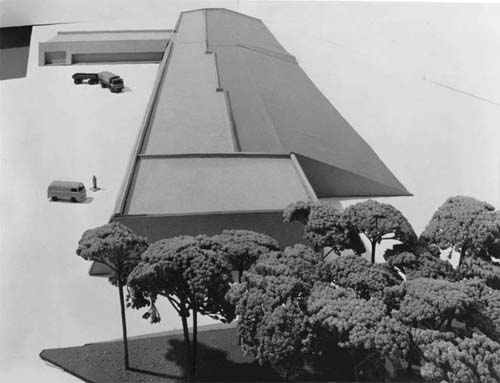The Press Release

View of the model of the Linac building, Dec. 1968
FOR RELEASE:
AM EDITIONS
THURSDAY, NOVEMBER 21, 1968
Batavia, Ill.--Groundbreaking will be held Sunday, December 1, 1968, near here for the first permanent building in the research complex of the National Accelerator Laboratory (NAL) where the 200 Billion Electron Volt (BeV) accelerator will be located.
The National Accelerator Laboratory is operated for the United States Atomic Energy Commission by the Universities Research Association, Inc., which is an organization of 47 universities in the United States and one in Canada.
"We are committed to build this Laboratory in five years and this groundbreaking signifies that we are really in business and on schedule," said Dr. Robert Rathbun Wilson, the Director, in announcing the program.
Dr. Glenn T. Seaborg, Nobel laureate chemist and chairman of the U. S. Atomic Energy Commission, will be the principal speaker at the groundbreaking. AEC Commissioners James T. Ramey and Dr. Gerald F. Tape also will speak. Congressman Melvin H. Price, of Illinois, a member of the Joint Congressional Committee on Atomic Energy, and Dr. Norman F. Ramsey, President of the Universities Research Association, Inc, also will be featured in the program.
The National Accelerator Laboratory will be the home of the world's most powerful proton accelerator. It is being developed on a 6,800-acre site in the Fox River Valley region about 30 miles west of Chicago near the town of Batavia, Illinois. The facility will cost approximately $250,000,000 plus experimental equipment outlays. Approximately 2,000 people will ultimately work at the Laboratory which will be a national facility available to qualified scientists on an international basis.
NAL's first permanent building will house a linear accelerator, or Linac, which will serve as part of the 200 Billion Electron Volt Proton Accelerator to be built on the NAL grounds. The Linac will give the protons a boost in energy that will take them to 200 Million Electron Volts, one-thousandth of their ultimate energy in the NAL accelerator system.
Dr. Donald E. Young, who is in charge of the NAL Linac design, noted that no proton linear accelerator of an energy as large as 200 MeV has been operated as yet. "Its principles are well established," he said. "A 200 MeV proton linear accelerator is now being constructed as a new injector for the Alternating Gradient Synchrotron at the Brookhaven National Laboratory in New York." At present, a 100 Million Electron Volt proton linear accelerator, which is the injector for the 76 BeV proton accelerator at the Serpukhov Laboratory in the Soviet Union, is the highest energy proton linear accelerator in the world.
Dr. Young, who received his doctorate in physics at the University of Minnesota in 1959, helped to construct the 68 Million Electron Volt linear accelerator there. Prior to his appointment at NAL, he was a professor in the Department of Nuclear Engineering at the University of Wisconsin, Madison. Philip V. Livdahl, formerly of the Argonne National Laboratory, is in charge of liaison activities with the architect-engineers developing plans for the Linac Building.
The Linac will be built near the western boundary of the NAL site in DuPage and Kane counties. The property is being acquired for the U. S. Atomic Energy Commission by the State of Illinois. The Linac will be situated north of the intersections of Giese and Kautz roads, in Kane county.
It is expected that the Linac Building will take about 14 months to complete. The building will be approximately 500 feet long and 63 feet wide and will have an exterior of pre-cast concrete and glass. The building has been designed by DUSAF, a joint venture serving as architect-engineer-construction manager for the National Acclerator Laboratory. John Baird and William Powers, of the DUSAF staff, have been associated with Dr. Young and Mr. Livdahl in developing plans and specifications for the Linac structure.
Plans for the groundbreaking ceremony are being arranged under the direction of Dr. M. Stanley Livingston, Associate Director of the Laboratory. Representatives of the U.S. Atomic Energy Commission, the Universities Research Association, Inc., Federal, State, and local officials, as well as members of the high energy physics community will take part in the ceremony.
The Linac Building will house the first two of four separate NAL accelerators, each of which will come into play sequentially as protons are accelerated from rest to an energy of 200 Billion Electron Volts.
The four accelerators will play the following roles:
- In what is called a pre-accelerator providing the first stage of acceleration, hydrogen atoms first are stripped of their electrons in an electrical discharge. The remaining positively charged protons, which had formed the nuclei of the hydrogen atoms, are accelerated by a 750 kilovolt electric field, and gain an energy of 750 thousand electron volts (KeV).
- Protons are then accelerated from 750 KeV to an energy of 200 MeV in the linear accelerator, or Linac, which is approximately 500 feet long. This is the second stage of acceleration
- At 200 MeV, protons are injected into a booster accelerator, the third stage in the process, which carries them to an energy of 10 BeV. The booster is a rapid-cycling synchrotron approximately 500 feet in diameter.
- At 10 BeV, the protons are injected into the main accelerator, a synchrotron of 6,562 feet (1.24 miles) diameter and accelerated in this final stage to full energy. Initially, this energy will be 200 BeV, but more power supplies can be added later to increase the accelerator's peak energy to 400 BeV, or possibly to 500, BeV. After reaching maximum energy, the protons then are extracted and transported to experimental areas.
It is expected that the first 200 BeV beam of particles will be extracted from the main accelerator by the end of June, 1972.
The groundbreaking will be held less than two years after the selection of the site near Batavia was announced.


